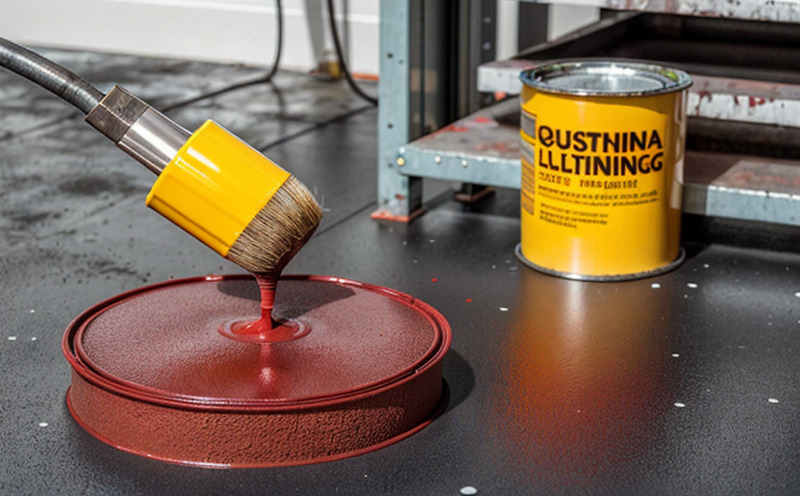ISO 8503 Surface Roughness Testing for Paint Adhesion
The ISO 8503 standard is a cornerstone in the field of industrial coatings, paints, and surface finishing. It provides a standardized method to assess the surface roughness which significantly impacts paint adhesion. This metric is critical in ensuring that coatings adhere effectively, thereby enhancing the durability and longevity of industrial manufacturing components.
Surface roughness plays a pivotal role in determining how well a coating will bond with the substrate. A poorly prepared or overly smooth surface can lead to poor adhesion, while an excessively rough surface might compromise the quality of the finish due to oversaturation. ISO 8503 addresses these challenges by offering precise guidelines and measurements for surface preparation.
The standard consists of three parts: A1 (Rz), A2 (Ra), and A3 (Rx). Part A1 measures roughness with a mean value, part A2 provides an arithmetic average height, while part A3 assesses the maximum peak-to-valley distance. Each method is applicable under different circumstances depending on the type of coating material and its application requirements.
For industrial manufacturing processes, ensuring that the surface meets the required roughness criteria not only enhances paint adhesion but also improves overall product performance. This ensures that coatings do not peel off prematurely or fail to protect surfaces from environmental stressors such as humidity, temperature fluctuations, or mechanical abrasion.
The testing process involves several key steps: preparation of the specimen, measurement using a profilometer, and analysis of results against specified criteria. Profilometers are used to scan the surface and generate detailed profiles that reflect the roughness characteristics accurately. Once collected, these data points help determine whether the surface meets the necessary standards outlined by ISO 8503.
Industrial quality managers, compliance officers, R&D engineers, and procurement specialists benefit greatly from understanding this process. Compliance officers ensure adherence to industry regulations; R&D teams use these tests to innovate new coating technologies; while procurement professionals leverage the insights gained through testing to source high-performance materials.
The importance of ISO 8503 cannot be overstated in maintaining consistent quality across various industrial sectors including automotive manufacturing, aerospace engineering, and construction. By adhering strictly to this standard, manufacturers can significantly reduce maintenance costs associated with re-coating efforts and extend the operational life of their products.
In conclusion, implementing ISO 8503 surface roughness testing for paint adhesion ensures robust adherence between coating layers and substrates. This leads to enhanced durability, improved performance, and reduced lifecycle costs—all critical factors in modern industrial manufacturing operations.
Scope and Methodology
The scope of ISO 8503 surface roughness testing encompasses a wide range of industrial applications where paint adhesion is paramount. This includes but is not limited to automotive manufacturing, aerospace engineering, construction, and marine industries.
To perform the test according to ISO 8503, it's essential to follow these steps:
- Prepare the specimen by cleaning it thoroughly.
- Select an appropriate profilometer for accurate measurement.
- Conduct measurements in accordance with specified parameters outlined by the standard.
The methodology involves measuring both the Rz and Ra values of the surface to ensure they fall within acceptable limits. For example, if you're working on a steel component destined for automotive use, achieving an Rz value between 50 μm and 125 μm ensures optimal paint adhesion.
It's important to note that different parts may require varying levels of surface roughness depending on their intended function. Aerospace components might need more precise measurements than those used in construction projects due to the extreme environmental conditions they must withstand.
The proficiency required for performing these tests includes understanding both theoretical aspects and practical applications. Operators should undergo training specifically tailored towards operating profilometers correctly and interpreting results accurately.
Competitive Advantage and Market Impact
Adhering to ISO 8503 surface roughness testing provides significant competitive advantages in the industrial manufacturing sector. Compliance with this standard ensures that products meet stringent quality benchmarks, thereby enhancing customer satisfaction and trust.
In today’s global market where competition is fierce, meeting or exceeding industry standards sets manufacturers apart from their competitors. By demonstrating commitment to excellence through rigorous testing procedures like those prescribed by ISO 8503, companies can establish themselves as leaders in their respective fields.
The use of advanced profiling equipment not only meets current regulatory requirements but also prepares organizations for future challenges and opportunities within the market landscape. As regulations evolve, staying ahead requires continuous improvement in processes and technologies used during manufacturing stages.
Additionally, incorporating ISO 8503 into routine quality control checks helps identify potential issues early on, preventing costly mistakes further down the line when products reach final assembly or distribution points. Early detection allows for timely adjustments to be made ensuring smoother production runs overall.
Use Cases and Application Examples
| Application Case | Description |
|---|---|
| Aerospace Manufacturing | In this sector, materials like aluminum alloys need precise surface roughness to ensure that protective coatings adhere properly against harsh atmospheric conditions. |
| Marine Engineering | Steel structures exposed to saltwater require robust paint finishes. ISO 8503 ensures the right surface treatment for long-lasting protection. |
| Automotive Assembly | Paint adhesion is critical in automotive manufacturing. Properly roughened surfaces enhance the durability of vehicle body parts, improving overall safety and longevity. |
| Construction Materials | Concrete and other construction materials often undergo surface preparation before receiving protective coatings to ensure optimal adhesion properties. |
| Furniture Manufacturing | Wooden furniture pieces benefit from surface roughening techniques that improve paint adhesion, leading to more aesthetically pleasing finishes. |
| Machinery Fabrication | In machinery fabrication, ensuring proper surface preparation can extend the service life of components exposed to heavy wear and tear conditions. |
These examples illustrate how ISO 8503 surface roughness testing plays a crucial role across various industries. By adhering strictly to these standards, manufacturers can guarantee high-quality products that meet customer expectations while maintaining compliance with international regulations.





